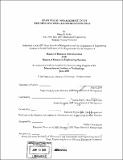Lean visual management in an ERP/MES-controlled production cell
Author(s)
Kisby, Brian M. (Brian Matthew)
DownloadFull printable version (32.60Mb)
Alternative title
Lean visual management in an Enterprise Resource Planning /Manufacturing Execution Systems-controlled production cell
Other Contributors
Leaders for Manufacturing Program.
Advisor
Janice Klein and Deborah Nightingale.
Terms of use
Metadata
Show full item recordAbstract
As a company grows, more and more effort is needed to control and coordinate operations. Typically, this is accomplished through an evolving collection of systems and processes, such as an Enterprise Resource Planning (ERP) system, but such systems also influence how a company does business, reviews performance, and communicates results. Manufacturing Execution Systems (MES) are often used in conjunction with ERP systems to streamline and enable actual manufacturing processes. A third type of system, the visual management system, is used to take production out of the closed, computerized realm and make it open, intuitive, and efficient. Visual Management, as a lean concept, can be a simple and effective means to efficiently regulate inventory levels and production activities. However, when visual management systems are to be embedded within a broader ERP/MES system, certain conditions and support systems are requisite, the absence of which will render the visual management system ineffective, at best, or destructive, at worst. Furthermore, there are fundamental issues around implementing visual management, be it high-tech or low-tech. This thesis will describe a case study of the process to manage the design and implementation of a visual management system, while addressing various stakeholders' needs and refined business objectives. Theories and frameworks of Enterprise Architecting and Change Management are utilized to analyze which functions the visual management system should perform and how to achieve operator buy-in.
Description
Thesis (M.B.A.)--Massachusetts Institute of Technology, Sloan School of Management; and, (S.M.)--Massachusetts Institute of Technology, Engineering Systems Division; in conjunction with the Leaders for Manufacturing Program at MIT, 2009. Includes bibliographical references (p. 94).
Date issued
2009Department
Leaders for Manufacturing Program at MIT; Massachusetts Institute of Technology. Engineering Systems Division; Sloan School of ManagementPublisher
Massachusetts Institute of Technology
Keywords
Sloan School of Management., Engineering Systems Division., Leaders for Manufacturing Program.